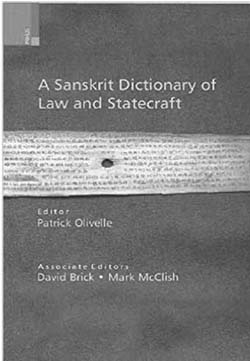The nature and purport of this book is clearly explained by its title. It is a dictionary in English of technical terms, legal, political and administrative, used in the Sanskrit language.
Such works on Sanskrit already exist for grammar and priestly rituals. The most recent are Abhyankar and Shukla’s A Dictionary of Grammar, 1986, and Sen’s A Dictionary of Vedic Rituals, 1978. The need for one on law, statecraft and political science prompted the present compilation, it being felt that technical terms on these subjects were not available sufficiently in standard Sanskrit-English dictionaries. This work is now offered by its editors with ‘deep satisfaction to … Sanskritists, historians of India and scholars of comparative law and legal history’.
Perhaps they could have also taken into account the possibility and desirability of a wider and more general interest. In present popular perception Sanskrit has tended to become associated mainly with religion and philosophy. Other aspects of this great language and its literature have as such receded somewhat into the background. From there they now deserve a greater exposure. That some of them are about usage in areas of current high profile like legislation and litigation, politics and governance, strategy and diplomacy could be of particular interest in modern times. Such usage is evident from the collection here reviewed. It brings together over three thousand words, terms and their definitions, together with citations from representative textual excerpts to illustrate their use. That Sanskrit was also a language intimately involved with such worldly life is quite clear from this scholarly compendium.
The dictionary entries are listed under fifty-one major topics detailed in the book’s Introduction. These include sedition and verbal abuse, crime and punishment, plaintiff and defendant, debtor and creditor, wages and women’s property, to name just a few as examples. Their sourcing ranges from ancient mulasmriti legal texts and commentaries, the Arthasastra and related dissertations, the two great epics and a host of other texts. Medieval works like the Lekhapaddhati, and modern ones like Joshi’s Dharmakosa and Kane’s History of the Dharmasastra are also taken into account. Each word is given in the Devanagari and the Roman script with textual citations to further explain meanings. These quotations are drawn from over sixty primary sources also listed in the book.
Apart from the technical texts already mentioned, the primary sources also include some well known Sanskrit works of general literature like the Panchatantra fables and the Kathasaritsagara stories, the histories Harsacarita and Rajataringini, and the plays Mrcchakatika of Sudraka and Sakuntala of Kalidasa. This indicates that the specialized terminology here compiled was also found in popular literature. That legal and political terms in Sanskrit were not infrequently also used in works other than scholarly and mainly literary, is an aspect deserving to be better known today.

